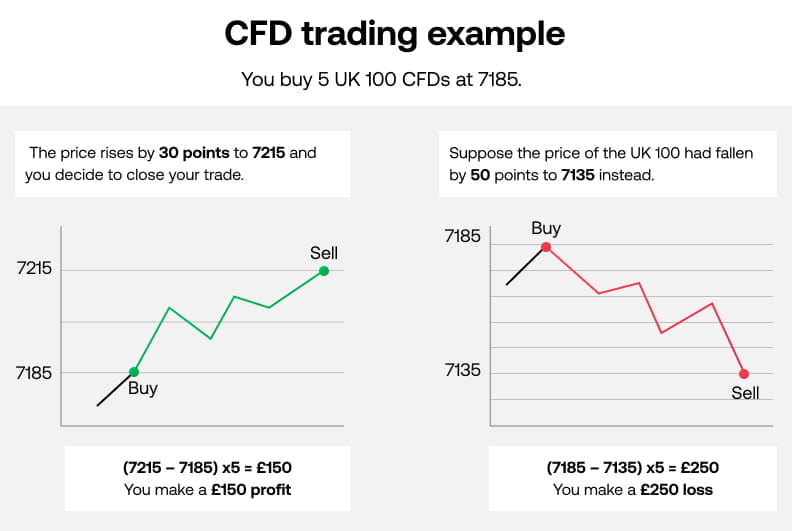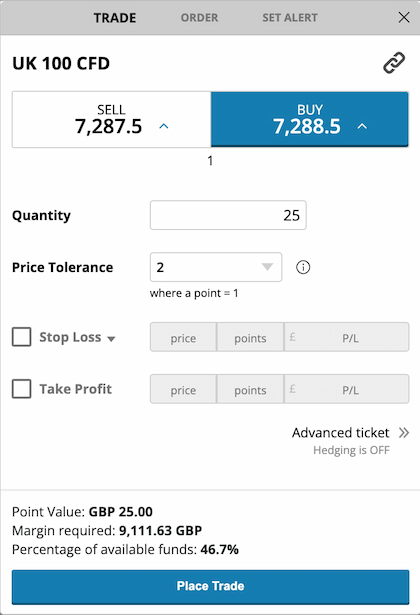
Trading with leverage
CFD trading explained
CFD trading is a popular means of trading financial markets using leverage. Find out everything you need to know about CFDs, including how they work and the steps to opening your first trade.
- Understanding CFD trading
- How does a CFD trade work?
- CFD trading example
- Why trade CFDs?
- How to start CFD trading
Understanding CFD trading
CFD trading is the use of contracts for difference (CFDs) to speculate on the price of a financial market. Here are a few key things you should know:
- CFDs are derivatives
- You can go long and short
- CFDs are tax-efficient
- You’ll have access to 5000+ markets
- CFDs are charged via the spread
Unlike traditional investing, when you trade CFDs you won’t ever take ownership of the underlying asset. Instead, CFDs take their value from the underlying market price
As you don’t own the asset, you can take advantage of markets that are falling in price, as well as those that are rising
As you don’t own the underlying asset, you don’t have to pay UK stamp duty and you can offset profits against losses for tax purposes*
You can trade a range of markets including shares, indices and commodities from a single City Index account
When you open a CFD trade, you’ll see a buy and sell price, the difference between them is the spread. The narrower the spread, the less the price will have to move before you make a profit or a loss. The only exception is share CFDs, which are charged via commission
How does a CFD trade work?
A CFD trade works by tracking the underlying price of an asset, whether that’s a physical share, ounce of gold or barrel of oil. When you buy or sell a CFD, you’re saying whether you expect that underlying price to rise or fall in value.
For every point the price moves in your favour, you’ll profit, and for every point it moves against you, you’ll make a loss. You’ll then multiply this figure by however many CFDs you bought in the first place.
Let’s look at an example of how that works in practice.
CFD trading example

You decide to trade the UK 100 – our market that tracks the price movements of all the stocks listed on the FTSE 100 index – buying 5 CFDs at the current market price of 7185.
As CFDs are leveraged, you’d only need to put down 5% of the total value – in this case, £1,796.25 (5x7185x0.05).
There are two possible outcomes:
- The FTSE 100 rises in value
- The FTSE 100 falls in value
If you were correct and the UK 100 increased, you’d earn £5 for every 1 point the index went up. So, let’s say you chose to close your trade when its price had risen by 30 points, you’d have made £150 in profit
If your prediction was wrong, and the UK 100 fell in price, you’d lose £5 for every 1 point the index decreased. So, if the price fell by 50 points instead, you’d have lost £250
Remember, CFDs are leveraged. Leverage can magnify your profits and losses as both will be based on the full exposure of the trade, not just the margin required to open it.
Why trade CFDs?
Trading CFDs is popular as a means of accessing financial markets on its own, or as just one part of a more complex investment strategy. Here are a few ways you can use CFDs:
- Hedging – protect your portfolio from adverse market movements by going short or trading correlated markets. As CFD profits can be offset against losses, they’re popular among hedgers
- Diversification- spread your capital across asset classes, sectors and geographical locations to make sure all your eggs aren’t in one basket
- Speculation-find short-term opportunities in volatility. There’s no bet duration, so you can hold positions open for seconds, minutes, hours or longer
How to start CFD trading
- Find your opportunity
- Open a CFD account
- Choose whether to go long or short
- Fill out the deal ticket
- Monitor and close your trade
There are thousands of markets available for you to trade, your choice will come down to your interests, available capital and risk tolerance. To help make your decision, use our range of tools including expert news and analysis, economic calendar and in-platform Reuters feed.
Create an account with City Index and be ready to trade in minutes. Not ready to speculate on live markets? You can open a demo account instead to practise opening CFD positions in a risk-free environment.
Do your research and decide whether you think the market is going to rise or fall. You might choose to use technical analysis – which is the use of historical price charts and indicators – or fundamental analysis, which looks at macroeconomic data, news and company earnings.
To open a CFD trade, you’ll need to decide how many contracts you’ll buy or sell. This will not only dictate how much your margin will be to open the trade, but how much profit or loss you’ll make per point of movement.

This is also the point you can add your orders – whether that’s a stop loss or take profit (or both). Take a look at our ‘How to trade’ lesson for more on the types of orders available.
While your CFD trade is open, you’ll be able to monitor your running profit or loss in the open positions tab. You’ll also be able to see your current margin level at the top of your screen.

When you’re ready to close your trade, you’ll need to reverse your position – either by manually taking the opposite position, or simply selecting ‘close’. If you attached a stop or limit, your trade will close automatically.
*Spread Betting and CFD Trading are exempt from UK stamp duty. Spread betting is also exempt from UK Capital Gains Tax. However, tax laws are subject to change and depend on individual circumstances. Please seek independent advice if necessary.

